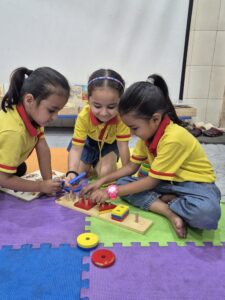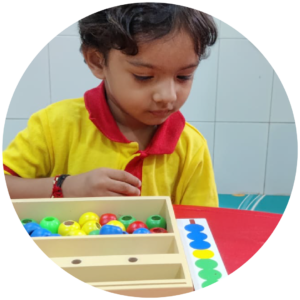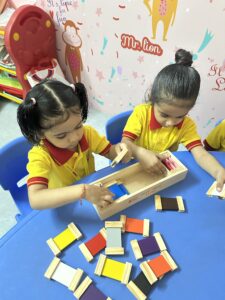- Email info@shantijuniors.com
- Phone +91 99796 66660

Have you noticed your 3-year-old struggling with buttons or dropping spoons during mealtime? Fine motor skills activities are exactly what they need to develop those tiny hand muscles and coordination.
During these crucial developmental years, children are rapidly building the dexterity they’ll use for essential life skills like writing, drawing, and self-care tasks. However, the good news is that you don’t need expensive equipment or professional guidance to help them progress. The most effective fine motor activities are often the simplest ones you can do right at home.
This article presents five engaging activities specifically designed for 3-year-olds that will strengthen their hand muscles while keeping them entertained. From squishing colorful playdough to creating sticker art masterpieces, these activities transform important developmental work into playtime fun. Additionally, we’ll explain exactly how each activity benefits your child’s development and provide easy step-by-step instructions to get started today.
Playdough ranks among the most versatile and beloved tactile materials for young children. This simple, squishy substance offers endless creative possibilities while secretly building crucial hand strength and coordination in your 3-year-old.
Playdough creations involve manipulating soft, pliable dough into various shapes, objects, and designs. This moldable material comes in vibrant colors and can be store-bought or homemade. Beyond the traditional rolling and flattening, playdough creations can include making pretend food, animals, letters, or abstract sculptures.
The beauty of playdough lies in its simplicity—it requires no special skills to begin yet offers infinite possibilities for creativity. Your child might start by simply squeezing and poking, then gradually progress to rolling “snakes,” forming balls, and eventually creating more complex structures as their skills develop.
Playdough activities strengthen the small muscles in your child’s hands, wrists, and fingers—precisely the muscles needed for tasks like writing, cutting, and buttoning. When your 3-year-old squeezes, pinches, rolls, or flattens playdough, they develop hand-eye coordination and bilateral coordination (using both hands together).
Furthermore, playdough play builds finger dexterity as children use different finger movements to create various shapes. The resistance provided by the dough naturally strengthens hand muscles without feeling like work. This tactile experience also helps children understand concepts like texture, weight, and cause-effect relationships.
Most importantly, playdough activities can be adjusted to match your child’s current skill level. As they master basic squeezing and poking, you can introduce tools like plastic knives, cookie cutters, or rolling pins to challenge their developing abilities.
Setting up playdough play requires minimal preparation but offers maximum engagement. First, gather your supplies:
To begin, establish a comfortable workspace at a child-sized table or on the floor with a protective covering. Start with a baseball-sized amount of playdough—too much can overwhelm young children. Demonstrate basic techniques like rolling, squeezing, and flattening, then allow your child to explore independently.
For enriched play, introduce themes that interest your child. If they love animals, suggest creating a zoo. For vehicle enthusiasts, make cars with button wheels. Kitchen pretend play works wonderfully with playdough “food.”
To maintain engagement, rotate available tools and accessories periodically. One day offer cookie cutters, another day provide straws for poking holes or making playdough “hair.”
Homemade playdough offers additional benefits as your child can help with measuring and mixing ingredients—adding another layer of fine motor practice. A simple recipe includes flour, salt, water, oil, and food coloring, cooked briefly on the stove or even made uncooked.
Remember that the process matters more than the product. Rather than focusing on creating perfect objects, praise your child’s effort, experimentation, and problem-solving. Through regular playdough sessions, you’ll notice steady improvement in your child’s hand strength, coordination, and confidence in manipulating materials.
Bead threading activities offer captivating challenges that keep little hands busy while building crucial dexterity skills. Unlike other sensory activities, bead threading combines focused attention with precise finger movements in a way that feels like play rather than practice.
Bead threading involves stringing beads, buttons, or similar objects onto laces, pipe cleaners, or strings. This classic activity requires children to coordinate their fingers to pick up small objects and guide them onto a string—actions that directly translate to many everyday skills. The activity can be as simple as threading large wooden beads onto a shoelace or as complex as creating patterns with various sizes, shapes, and colors.
Depending on your child’s developmental stage, you might start with larger beads and thicker strings, gradually introducing smaller components as their skills improve. The activity naturally evolves with your child, making it an excellent long-term investment in their development.
Bead threading significantly enhances several developmental areas in 3-year-olds. First, it builds pincer grasp—the thumb and forefinger coordination needed for writing, buttoning clothes, and using utensils. This precise movement strengthens the same small hand muscles used for more advanced skills later.
Moreover, threading activities develop hand-eye coordination as children must visually track both the bead and the string while guiding one through the other. This skill transfers directly to drawing, writing, and self-care tasks.
Beyond physical development, bead threading encourages concentration and perseverance. Young children must focus to complete the task, building attention spans and the satisfaction of overcoming challenges. The activity likewise introduces basic math concepts through sorting, counting, and pattern creation with different colored beads.
Setting up bead threading requires minimal materials but offers maximum engagement. To get started:
For children who find regular beads challenging, begin with threading larger objects like toilet paper rolls onto rope or pool noodle sections onto dowels. As their skills advance, introduce smaller beads and thinner strings.
To maintain interest, rotate available materials periodically. One day offer colorful plastic beads, another day provide natural wooden ones or unique materials like cut straws or O-shaped cereal.
Safety remains paramount when working with small objects. Always supervise bead threading activities closely, especially with younger 3-year-olds. Choose beads that are large enough not to pose choking hazards—generally larger than a quarter for this age group.
Store beading materials in containers with secure lids when not in use. Count beads before and after activities to ensure none have been lost where younger siblings might find them.
Consider using pipe cleaners or plastic-tipped laces instead of string for beginners, as they provide structure that makes threading easier while eliminating potential entanglement concerns. Finally, establish clear rules about keeping beads away from mouths, noses, and ears.
Through regular bead threading sessions, you’ll notice impressive development in your child’s hand control, focus, and confidence with manipulative tasks—all while they enjoy creating their own special treasures.

Colorful, lightweight pom-poms transform ordinary sorting activities into irresistible play experiences for 3-year-olds. These fuzzy balls appeal to children’s natural curiosity while secretly strengthening the tiny muscles in their hands and fingers.
The pom-pom sorting game involves categorizing soft, tactile pom-poms by color, size, or other attributes using various tools and containers. This simple yet effective activity requires children to pick up individual pom-poms and place them into designated containers, cups, or compartments.
At its core, the game involves pinching, grasping, and releasing—fundamental movements for developing hand control. What makes this activity particularly valuable is its adaptability; parents can easily adjust the difficulty by changing the size of pom-poms or introducing tools like tweezers or tongs as children master basic skills.
The activity typically starts with using fingers to sort larger pom-poms and gradually progresses to using tools for manipulating smaller pieces, creating a natural developmental progression that grows with your child.
Pom-pom sorting activities excel at developing precise finger control and hand-eye coordination. As children pinch and grasp these lightweight objects, they strengthen the same finger muscles needed for buttoning clothes, holding pencils, and manipulating small objects.
Additionally, the activity enhances hand-eye coordination as children must visually track both the pom-pom and the container while guiding one to the other. This visual tracking coupled with finger manipulation builds neural pathways essential for future writing skills.
Beyond physical development, sorting activities introduce early math concepts through classification, color recognition, and pattern creation. The task likewise builds concentration as children focus on completing each sorting challenge.
Setting up this engaging activity requires minimal preparation:
For beginners, start with larger pom-poms sorted by hand into clearly marked containers. Once comfortable with basic sorting, introduce tools like plastic tweezers for an added challenge. You might color-code containers or use pictures to indicate where each pom-pom belongs.
To maintain interest, periodically change the sorting criteria—sort by size one day, by color another, or create patterns in ice cube trays. Consider timing challenges for enthusiastic sorters or incorporating counting activities for added educational value.

Stickers captivate preschoolers with their colorful designs and sticky backing, making them perfect tools for developing precision and control. Creating sticker art collages combines creativity with important finger skills practice in a way that seems purely fun to your child.
A sticker art collage involves placing various stickers onto paper or cardboard to create pictures, patterns, or designs. This activity requires children to peel stickers from their backing—a precise task that challenges tiny fingers—and place them intentionally onto a surface. For 3-year-olds, the process matters more than the final product, as they experiment with placement, overlap, and arrangement of different stickers.
Peeling stickers develops the pincer grasp (thumb and forefinger coordination) essential for writing and self-care tasks. Indeed, the careful manipulation required to separate a sticker from its backing strengthens finger muscles and improves dexterity.
Essentially, sticker activities encourage hand-eye coordination as children must visually guide their stickers to specific locations. The process of positioning multiple stickers requires spatial awareness and planning skills. Additionally, working with various sticker sizes challenges different aspects of finger control, from precise movements with tiny stickers to broader movements with larger ones.
Start by gathering materials and creating a comfortable workspace. Demonstrate how to peel stickers by slightly bending the backing paper. For beginners, choose stickers with easy-to-grip edges. Provide a blank paper and allow your child to place stickers wherever they wish, gradually introducing concepts like creating scenes or patterns.
Occasionally, introduce themed collages based on your child’s interests—perhaps animals, vehicles, or favorite characters. Create simple scenes on paper where stickers can be added (like fish stickers on a blue “ocean” background). For added learning, use stickers for counting games or color matching activities. Reusable sticker books offer extended practice opportunities without consuming disposable stickers.
Keep these supplies readily available:
Remember that success with stickers builds confidence that transfers to other fine motor challenges. Through regular sticker play, your child gradually masters the controlled movements needed for future writing and crafting skills.
Introducing scissors to your 3-year-old marks an exciting milestone in their fine motor development journey. This skill builds upon the pincer grasp and coordination established through earlier activities.
Cutting practice involves teaching children how to manipulate scissors to snip, cut along lines, and eventually create shapes from paper. For 3-year-olds, this begins with simple snipping motions and gradually progresses to cutting along straight lines, curves, and zigzags as their skills advance.
Scissors require bilateral coordination—using both hands simultaneously for different tasks. One hand controls the scissors while the other holds and manipulates the paper. Subsequently, this strengthens hand muscles differently than other activities, as children must open and close their fingers against resistance. Notably, this action develops the separation between the two sides of the hand, crucial for advanced skills like handwriting.
Begin with supervised sessions lasting 5-10 minutes. Start with simple snipping activities on playdough or paper strips prior to introducing lines. Consequently, establish clear rules—scissors remain at the table, point down when walking, and are stored properly after use. Always model proper technique by demonstrating thumb-up positioning.
Choose blunt-tipped safety scissors specifically designed for preschoolers. Spring-loaded training scissors help beginners by automatically reopening after each cut. Alternatively, loop scissors accommodate small hands still developing proper finger placement.
Fine motor skill development plays a crucial role in your 3-year-old’s growth journey. Throughout this article, we’ve explored five engaging activities that transform essential developmental work into playful experiences your child will genuinely enjoy. Playdough creations strengthen hand muscles through squeezing and molding, while bead threading enhances pincer grasp and hand-eye coordination. Additionally, pom-pom sorting games develop precise finger control, sticker art collages improve dexterity, and cutting practice builds bilateral coordination.
The beauty of these activities lies in their simplicity and accessibility. You likely already have many of the required materials at home, and those you don’t can be purchased inexpensively or substituted with household items. Although these activities might seem basic, they deliver powerful developmental benefits that prepare your child for future skills like writing, drawing, and self-care tasks.
Remember that consistency matters more than perfection. Even short, regular sessions of these activities will help your child steadily improve their fine motor skills. Most importantly, your 3-year-old won’t view these as “exercises” but rather as fun playtime opportunities to explore and create alongside you.
Your patience and encouragement during these activities will foster not only physical development but also confidence and problem-solving abilities. Therefore, set aside a few minutes each day for one of these activities and watch your child’s skills flourish. Their tiny fingers will thank you as they master increasingly complex tasks with growing confidence and independence.